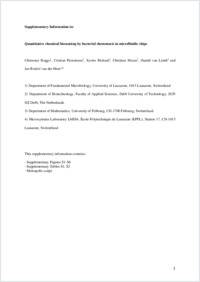Quantitative chemical biosensing by bacterial chemotaxis in microfluidic chips: Chemotaxis-microfluidic biosensor
- Roggo, Clémence Department of Fundamental Microbiology, University of Lausanne, Switzerland
- Picioreanu, Cristian Department of Biotechnology Faculty of Applied Sciences, Delft University of Technology, Delft, The Netherlands
- Richard, Xavier Department of Mathematics, University of Fribourg, Switzerland
- Mazza, Christian Department of Mathematics, University of Fribourg, Switzerland
- Lintel, Harald van Microsystems Laboratory LMIS4, École Polytechnique Fédérale de Lausanne (EPFL), Switzerland
- Meer, Jan Roelof van der Department of Fundamental Microbiology, University of Lausanne, Switzerland
-
2018
Published in:
- Environmental Microbiology. - 2018, vol. 20, no. 1, p. 241–258
English
Whole-cell bacterial bioreporters are proposed as alternatives to chemical analysis of, for example, pollutants in environmental compartments. Commonly based on reporter gene induction, bioreporters produce a detectable signal within 30 min to a few hours after exposure to the chemical target, which is impractical for applications aiming at a fast response. In an attempt to attain faster readout but maintain flexibility of chemical targeting, we explored the concept for quantitative chemical sensing by bacterial chemotaxis. Chemotaxis was quantified from enrichment of cells across a 600 µm- wide chemical gradient stabilized by parallel flow in a microfluidic chip, further supported by transport and chemotaxis steady state and kinetic modelling. As proof- of-concept, we quantified Escherichia coli chemotaxis towards serine, aspartate and methylaspartate as a function of attractant concentration and exposure time. E. coli chemotaxis enrichment increased sharply between 0 and 10 µM serine, before saturating at 100 µM. The chemotaxis accumulation rate was maximal at 10 µM serine, leading to observable cell enrichment within 5 min. The potential application for biosensing of environmental toxicants was investigated by quantifying chemotaxis of Cupriavidus pinatubonensis JMP134 towards the herbicide 2,4- dichlorophenoxyacetate. Our results show that bacterial chemotaxis can be quantified on a scale of minutes and may be used for developing faster bioreporter assays.
- Faculty
- Faculté des sciences et de médecine
- Department
- Département de Mathématiques
- Language
-
- English
- Classification
- Biological sciences
- License
-
License undefined
- Identifiers
-
- RERO DOC 306749
- DOI 10.1111/1462-2920.13982
- Persistent URL
- https://folia.unifr.ch/unifr/documents/306522
Other files
Statistics
Document views: 144
File downloads:
- pdf: 152
- Texte intégral: 134

